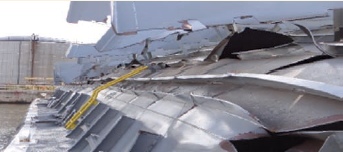202032 Gas freeing risks
As edited from US Coast Guard Marine Safety Alert 01-20
On a tank barge, personnel were preparing to undertake gas freeing of the cargo tanks. Cargo tank booby hatches and Butterworth openings were open and the flammable vapours within the cargo tank were being removed with mechanical air moving equipment. There was an explosion and the barge sustained extensive damage.
The investigation established that when outside air is introduced into the cargo tank during gas freeing, the vapour/air mixture within the tank and near the tank openings can reach the flammable range. If the air moving equipment used to gas free the cargo tank is not the proper type, is not properly maintained, or is not properly electrically bonded(grounded) and secured to the vessel’s structure, static electricity generated by the equipment can discharge as an electric arc and ignite the flammable mixture.
The air blowers that were recovered from the exploded tank barge had either missing or improperly maintained bonding (ground) wires. This was likely the cause of the explosion.

Breached cargo tank
Lessons learned
- All personnel should be aware of the critical importance of bonding(grounding) air moving equipment such as blowers or fans before commencing gas freeing operations.
- Proper bonding means the contact point to the vessel or barge is clamped to bare metal, not a painted surface. Simply resting the blower/fan on bare metal is NOT an adequate means of bonding.
- Clamps used with the bonding wire or strap should be free of corrosion, with sufficient tension to ensure a tight connection when clamped to the vessel structure.
- Fans or blowers should be properly secured to prevent movement due to vibration.
- Inspect all air moving equipment before first use each day and ensure that all attached accessories (cones, ducting, etc.) are tightly connected to the blower/fan.
